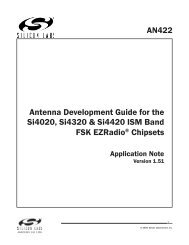C8051F326/7 - Silicon Labs
C8051F326/7 - Silicon Labs
C8051F326/7 - Silicon Labs
You also want an ePaper? Increase the reach of your titles
YUMPU automatically turns print PDFs into web optimized ePapers that Google loves.
15.2. C2 Pin Sharing<br />
<strong>C8051F326</strong>/7<br />
The C2 protocol allows the C2 pins to be shared with user functions so that in-system debugging and<br />
Flash programming may be performed. This is possible because C2 communication is typically performed<br />
when the device is in the halt state, where all on-chip peripherals and user software are stalled. In this<br />
halted state, the C2 interface can safely ‘borrow’ the C2CK (/RST) and C2D (P3.0) pins. In most applications,<br />
external resistors are required to isolate C2 interface traffic from the user application. A typical isolation<br />
configuration is shown in Figure 15.1.<br />
/Reset (a)<br />
Input (b)<br />
Output (c)<br />
C2 Interface Master<br />
Figure 15.1. Typical C2 Pin Sharing<br />
The configuration in Figure 15.1 assumes the following:<br />
<strong>C8051F326</strong>/7<br />
C2CK<br />
C2D<br />
1. The user input (b) cannot change state while the target device is halted.<br />
2. The /RST pin on the target device is used as an input only.<br />
Additional resistors may be necessary depending on the specific application.<br />
Rev. 1.1 137


